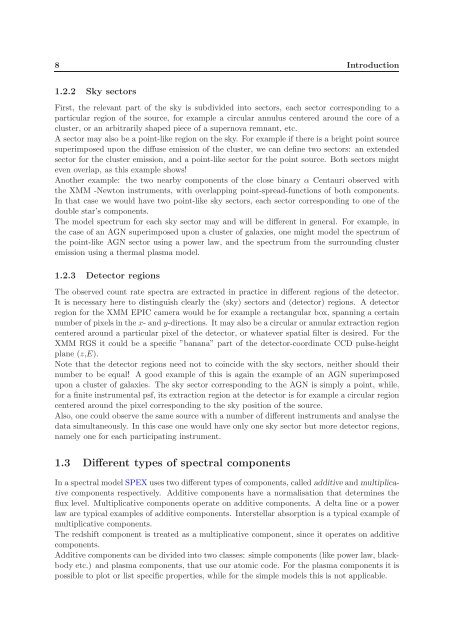SPEX User's Manual - SRON
SPEX User's Manual - SRON
SPEX User's Manual - SRON
You also want an ePaper? Increase the reach of your titles
YUMPU automatically turns print PDFs into web optimized ePapers that Google loves.
8 Introduction<br />
1.2.2 Sky sectors<br />
First, the relevant part of the sky is subdivided into sectors, each sector corresponding to a<br />
particular region of the source, for example a circular annulus centered around the core of a<br />
cluster, or an arbitrarily shaped piece of a supernova remnant, etc.<br />
A sector may also be a point-like region on the sky. For example if there is a bright point source<br />
superimposed upon the diffuse emission of the cluster, we can define two sectors: an extended<br />
sector for the cluster emission, and a point-like sector for the point source. Both sectors might<br />
even overlap, as this example shows!<br />
Another example: the two nearby components of the close binary α Centauri observed with<br />
the XMM -Newton instruments, with overlapping point-spread-functions of both components.<br />
In that case we would have two point-like sky sectors, each sector corresponding to one of the<br />
double star’s components.<br />
The model spectrum for each sky sector may and will be different in general. For example, in<br />
the case of an AGN superimposed upon a cluster of galaxies, one might model the spectrum of<br />
the point-like AGN sector using a power law, and the spectrum from the surrounding cluster<br />
emission using a thermal plasma model.<br />
1.2.3 Detector regions<br />
The observed count rate spectra are extracted in practice in different regions of the detector.<br />
It is necessary here to distinguish clearly the (sky) sectors and (detector) regions. A detector<br />
region for the XMM EPIC camera would be for example a rectangular box, spanning a certain<br />
number of pixels in the x- and y-directions. It may also be a circular or annular extraction region<br />
centered around a particular pixel of the detector, or whatever spatial filter is desired. For the<br />
XMM RGS it could be a specific ”banana” part of the detector-coordinate CCD pulse-height<br />
plane (z,E).<br />
Note that the detector regions need not to coincide with the sky sectors, neither should their<br />
number to be equal! A good example of this is again the example of an AGN superimposed<br />
upon a cluster of galaxies. The sky sector corresponding to the AGN is simply a point, while,<br />
for a finite instrumental psf, its extraction region at the detector is for example a circular region<br />
centered around the pixel corresponding to the sky position of the source.<br />
Also, one could observe the same source with a number of different instruments and analyse the<br />
data simultaneously. In this case one would have only one sky sector but more detector regions,<br />
namely one for each participating instrument.<br />
1.3 Different types of spectral components<br />
In a spectral model <strong>SPEX</strong> uses two different types of components, called additive and multiplicative<br />
components respectively. Additive components have a normalisation that determines the<br />
flux level. Multiplicative components operate on additive components. A delta line or a power<br />
law are typical examples of additive components. Interstellar absorption is a typical example of<br />
multiplicative components.<br />
The redshift component is treated as a multiplicative component, since it operates on additive<br />
components.<br />
Additive components can be divided into two classes: simple components (like power law, blackbody<br />
etc.) and plasma components, that use our atomic code. For the plasma components it is<br />
possible to plot or list specific properties, while for the simple models this is not applicable.

















